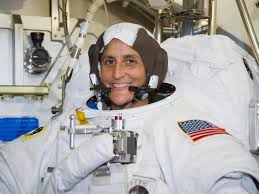WASHINGTON: The launch of Boeing’s Starliner spacecraft, scheduled to carry NASA astronauts Sunita Williams and Barry Wilmore to the International Space Station (ISS) was on Monday (local time) postponed after a valve glitch in the upper stage of the rocket set to propel it to space.
Rocket company United Launch Alliance’s Tom Heter III the director overseeing the launch announced the decision to delay the launch about two hours before the expected lift off from the Cape Canaveral Space Force Station in Florida, United States.
NASA announced on social media platform X that the problem was identified with an oxygen valve on part of ULA’s Atlas 5 rocket and that the space agency, Boeing and ULA have “scrubbed the launch opportunity on May 6 for the agency’s Boeing Crew Flight Test to the International Space Station due to a faulty oxygen relief valve observation on the Atlas V rocket Centaur second stage. The crew and rocket remain safe and more information will be forthcoming.”
It said that NASA astronauts Wilmore and Williams exited the Starliner spacecraft at Space Launch Complex-41 at Cape Canaveral Space Force Station in Florida and will return to astronaut crew quarters.
This would have marked the first human crewed flight for Starliner with Indian origin Sunita “Suni” Williams piloting the craft with fellow NASA pilot Barry “Butch” Wilmore. Boing had designed Starliner to rival the Dragon capsule of Elon Musk’s SpaceX which carried out its crewed flight test in May 2020. SpaceX has handled most of NASA’s crew transportation needs since then.
However, just two hours before the scheduled launch, a valve glitch in the rocket’s upper stage forced mission managers to call off the mission. It was a frustrating setback for Wilmore and Williams, both seasoned astronauts ventured to space on two previous journeys aboard NASA space shuttle and Russian Soyuz missions and had impressive backgrounds in naval aviation. The disappointment was tangible as they unstrapped from their seats, their hopes of soaring into space momentarily grounded, CBS News reported.
Incidentally Sunita Williams has named the spacecraft “Calypso” for her love of the ocean and in reference to the ship of famed explorer Jacques Cousteau, who sailed across the world on his own ship named bearing the same name.
Despite the setback, the seasoned duo maintained their composure, knowing that space travel demands patience and resilience. Clad in their distinctive Boeing pressure suits, Wilmore and Williams awaited news of the next launch window, ready to embark on their celestial journey at the earliest opportunity, as reported by CBS News.
The Atlas 5 rocket, renowned for its reliability, stood ready for its milestone 100th flight – to launch Boeing’s Crew Space Transportation (CST)-100 Starliner spacecraft. The plan was that following separation from Atlas 5, Starliner engines will burn taking it the rest of the way to orbit and on to the International Space Station, according to ULA.
The Atlas 5 had successfully launching scientific spacecraft to Mars on five different occasions, plus research investigations to the Sun, the Moon, Jupiter, the Asteroid Bennu and Pluto The Atlas 5 consists of two major components: a booster and Centaur, its so-called upper stage. Starliner sits on top of Centaur, which in turn rests on the booster. The booster powers everything off the launchpad. During the flight, Centaur is designed to separate from the booster, propelling Starliner into a proper orbit. Then, Starliner separates from Centaur and flies on its own.
It has delivered US national security assets into space, launched weather observatories that all Americans depend upon and deployed commercial satellites to connect the world.
Williams, selected as an astronaut by NASA in June 1998, has spent a total of 322 days in space on two missions and accumulated 50 hours and 40 minutes of cumulative EVA time on seven spacewalks. Williams worked with Roscosmos on its contribution to the space station and with the first Expedition crew.
Meanwhile, 61-year-old, Wilmore has logged 178 days in space and has 25 hours and 36 minutes of time on four spacewalks.
NASA has been waiting half a decade for Starliner to begin flying crew, and the development of Starliner was beset by years of delays, setbacks and blunders. More broadly, Boeing as a company has suffered years of scandals in its aircraft division that have tarnished the legacy aerospace giant’s brand, CNN reported.
If successful, the Crew Test Flight could queue up Boeing to begin flying routine trips to the space station on NASA’s behalf.
Boeing has already planned six manned missions for the platform over the next six years, the projected end of the ISS’ operating lifespan.
NASA plans to use both SpaceX’s Dragon and Boeing’s Starliner to send up astronauts at least every six months from US soil. Both Boeing and SpaceX were given the responsibility in 2014 by NASA to send commercial crew missions to the ISS.
Boeing received over USD 4 billion in US federal funds to develop the Starliner, while SpaceX received about USD 2.6 billion.


